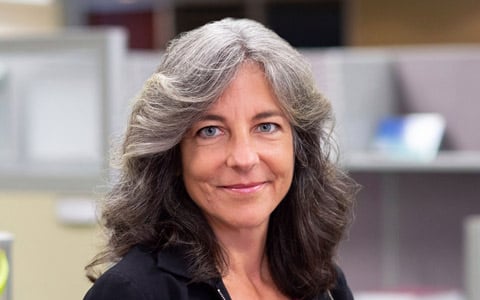
Amy Vaillancourt is the Director of Environmental Services in VHB’s Wethersfield office and has a passion for bringing brownfields back to life as productive properties within communities. She is a Connecticut Licensed Environmental Professional specializing in environmental site assessments and remediation, project planning, outreach, agency coordination, and property owner/developer negotiations. Over the last decade, Amy has assisted VHB clients with obtaining millions of dollars in state and federal grants for brownfield sites.
We interviewed Amy to learn why she loves this work, how brownfields revitalization boosts communities, how to mitigate gentrification, and how she leverages technology in this work.
VHB: For those unfamiliar with the concept, what are brownfields?
Amy: Brownfields are properties where real or perceived contamination hampers their reuse or redevelopment. These sites include former mills, factories, gas stations, and dry cleaners. Redeveloping brownfields involves transforming these underperforming liabilities into community assets by integrating various services—such as environmental cleanup, land development, transportation planning, permitting processes, stormwater controls, and public outreach. It's about taking something that negatively impacts a community and turning it into something beneficial.
VHB: Why are you passionate about brownfields redevelopment work?
Amy: It’s a win-win. Development of brownfield properties offers a unique opportunity to revitalize communities while addressing environmental concerns. The work leads to job creation and economic growth, but it also cleans up contaminated areas, reducing threats to waterways, wildlife, and local populations, often benefiting underrepresented communities. It's incredibly rewarding to see firsthand how these projects positively impact communities in tangible, visible ways within my lifetime.
VHB: Can you tell us about a specific community you’ve seen experience the benefits of brownfields work?
Amy: One of my first brownfield clients is a great example. I’ve seen Middletown, Connecticut, undergo a complete transformation. Back in 1995, the town received $200,000 under one of the first Environmental Protection Agency (EPA) brownfield pilot projects for the assessment of former industrial properties along Middletown’s riverfront. Over time, through additional grants, Middletown has transformed these areas significantly. One major success is the R. M. Keating Historical Enterprise Park. Formerly home to the Remington Rand typewriter company, a bicycle factory, an automobile manufacturer, and, during World War II, an ammunition manufacturer, VHB supported the City with revitalizing the historic industrial mill building and remediating the site using state and EPA funding. The site has been transformed into a very successful small business incubator that is now a public draw, hosting 24 different entrepreneur tenants, including two breweries, a hard cidery, several gyms, and various other businesses—and it’s powered by solar energy.
VHB: You called brownfields projects a win-win, but this work can also have downsides. How do you mitigate these?
Amy: It's true; redevelopment can lead to gentrification, potentially displacing current residents. We encourage developers to think holistically about their projects and consider community benefits. This might involve creating jobs, adding green spaces, or confirming new facilities are accessible to all neighborhood residents. By advocating for inclusive development, we aim to support community members rather than displacing them.
VHB: How do you leverage data and technology in your brownfields work?
Amy: Recently, we supported the City of Norwalk by conducting a survey among brownfields stakeholders, including developers, regulators, nonprofits, municipalities, and consultants. We developed a QR code postcard to gather anonymous feedback, distributing these at the 2023 National Brownfields Training Conference. The response was excellent, with 150 submissions from all over the country representing a good mix of stakeholders. Through analysis of the data, we were able to determine what brownfield information was most important to each stakeholder and why. We then used this information in developing a GIS brownfield inventory dashboard, which serves as a planning tool to support brownfield redevelopment in Norwalk. The QR code survey and GIS brownfield inventory attracted the attention of other VHB clients and brownfields stakeholders farther afield, leading us to share our innovative approach with a broader audience and paving the way for further collaborations.
Learn more about how VHB improves brownfields by emailing Amy or connecting on LinkedIn.


